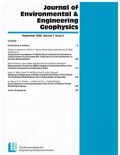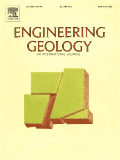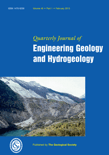
Bulletin of Engineering Geology and the Environment
Scope & Guideline
Pioneering research for a sustainable geological future.
Introduction
Aims and Scopes
- Landslide and Slope Stability Analysis:
Research on landslide susceptibility, prediction models, and slope stability under various environmental conditions, including rainfall and seismic activities. - Geotechnical Characterization and Modeling:
Studies focusing on the mechanical properties and behavior of geological materials, emphasizing the use of numerical simulations and physical modeling to understand soil and rock interactions. - Environmental Impact Assessments:
Evaluating the effects of construction and mining activities on geological and environmental systems, including studies on contamination and groundwater impacts. - Innovative Engineering Solutions:
Development and application of advanced engineering techniques and materials, such as grouting methods, soil stabilization, and the use of geosynthetics for slope protection. - Hydrological and Hydrogeological Studies:
Research on groundwater flow, seepage, and the effects of hydrological changes on geological stability, particularly in relation to mining and construction. - Risk Assessment and Management:
Assessment of geological hazards, including landslides, rockfalls, and earthquakes, focusing on risk management strategies and mitigation measures.
Trending and Emerging
- Machine Learning and Data-Driven Approaches:
There is a growing trend towards the application of machine learning and data analytics for predicting geological hazards, analyzing landslide susceptibility, and optimizing engineering designs. - Climate Change Impacts on Geological Stability:
Research focusing on the effects of climate change, such as increased rainfall and temperature fluctuations, on geological stability and landslide dynamics is gaining traction. - Integrated Geophysical Methods:
The use of multi-method geophysical approaches for assessing subsurface conditions and monitoring geotechnical hazards is on the rise, providing more comprehensive insights into geological contexts. - Sustainable Engineering Practices:
Emerging studies emphasize sustainable practices in geotechnical engineering, including the use of eco-friendly materials and techniques for soil stabilization and erosion control. - Advanced Numerical Modeling Techniques:
There is an increasing focus on sophisticated numerical modeling methods, such as discrete element modeling (DEM) and finite element methods (FEM), to analyze complex geological behaviors and interactions.
Declining or Waning
- Traditional Geotechnical Testing Methods:
There has been a noticeable decline in studies solely focused on conventional geotechnical testing methods, as newer, more advanced techniques and computational approaches gain prominence. - Basic Soil Mechanics:
Research directly related to fundamental soil mechanics principles seems to be waning, possibly due to the shift towards more complex interactions involving environmental factors and advanced modeling techniques. - Static Stability Analyses:
Static analyses of slope stability are becoming less common, with an increasing emphasis on dynamic and probabilistic methods that account for variability in geological conditions. - Case Studies on Non-complex Geological Settings:
The journal appears to be moving away from simple case studies in well-documented geological environments, favoring more complex and multifaceted geological scenarios. - Laboratory-Only Studies:
There is a declining trend in studies that rely solely on laboratory tests without field validation, as the focus shifts towards integrated field and laboratory approaches.
Similar Journals

International Journal of Physical Modelling in Geotechnics
Unveiling the complexities of soil and rock interactions.The International Journal of Physical Modelling in Geotechnics, published by Emerald Group Publishing Ltd, is a leading platform dedicated to advancing the field of geotechnical engineering and engineering geology. With a focus on the practical applications of physical modeling, this journal contributes significantly to the understanding of soil and rock behavior under various conditions, making it invaluable for researchers, professionals, and students alike. Heightened by its Q2 ranking in its category and a notable 61st percentile ranking among its peers, this journal has established itself as a credible source of knowledge and innovation within the academic community. Although it does not currently offer open access, its rigorous peer-review standards ensure the dissemination of high-quality research and insights. The journal, covering a timeline of topics from 2011 to 2024, aims to bridge the gap between theory and practice, ultimately fostering advancements in geotechnical solutions necessary for infrastructure development. To stay at the forefront of geotechnical research, contributing authors and engaged readers are encouraged to explore and participate in this dynamic academic discussion.

Australian Geomechanics Journal
Shaping the Future of Sustainable Geotechnical PracticesWelcome to the Australian Geomechanics Journal, a prominent platform for the dissemination of research in the field of geotechnical engineering and engineering geology, published by the Australian Geomechanics Society. With its ISSN 0818-9110, this journal has been a critical resource since its inception in 2000, and continues to serve the scholarly community as it converges through 2024. While indexed in Scopus, the journal ranks in the 9th percentile for its category, reflecting its important niche in the broader scientific discourse. Although it operates under a traditional access model, the Australian Geomechanics Journal is essential for researchers, professionals, and students seeking to enhance their knowledge on geotechnical applications and innovations. The journal not only caters to Australian interests but is also a vital contributor to global discussions on sustainable practices in geotechnical engineering.

Journal of Himalayan Earth Sciences
Connecting Research and Innovation in Earth SciencesThe Journal of Himalayan Earth Sciences (ISSN: 1994-3237; E-ISSN: 2305-6959) is a distinguished publication by UNIV PESHAWAR, dedicated to advancing knowledge in the field of earth sciences, particularly as they relate to the Himalayan region. Established in 2013, this journal aims to provide a platform for researchers, professionals, and students to share original research findings, reviews, and innovative methodologies that contribute to the understanding of geological and environmental phenomena in this ecologically significant area. Despite being categorized in Q4 of the Earth and Planetary Sciences, the journal showcases valuable contributions to the scientific community and encourages submissions that delve into both the challenges and advancements within Earth sciences, with a particular focus on the unique geological structures and processes of the Himalayas. As an open-access journal, it ensures that research is accessible to a global readership, promoting collaboration and discussion among scholars and practitioners. The journal's operational base in Peshawar, Pakistan, places it at the heart of Himalayan research, making it an invaluable resource for those invested in earth sciences.

Acta Geotechnica Slovenica
Connecting Theory and Practice in Earth Sciences.Acta Geotechnica Slovenica is a distinguished peer-reviewed journal published by the University of Maribor, Slovenia, that focuses on the fields of geology, geophysics, and geotechnical engineering. With an ISSN of 1854-0171, it showcases significant research contributions that enhance our understanding of geotechnical challenges and innovations. The journal has been active since 2008 and has gained recognition within the academic community, holding a Q3 quartile ranking in Geology and a Q4 ranking in Geophysics and Geotechnical Engineering and Engineering Geology as per the 2023 categorization. Even though there are no Open Access options available, the journal remains an important resource for researchers, professionals, and students alike, serving as a platform for disseminating impactful findings in earth science disciplines. Its relevance is underscored by its rankings in Scopus, positioning it among the notable journals in its field. Engaging with Acta Geotechnica Slovenica offers an invaluable opportunity to stay at the forefront of geotechnical research and advancements.

JOURNAL OF ENVIRONMENTAL AND ENGINEERING GEOPHYSICS
Exploring Subsurface Environments for Tomorrow's ChallengesJOURNAL OF ENVIRONMENTAL AND ENGINEERING GEOPHYSICS, published by the ENVIRONMENTAL ENGINEERING GEOPHYSICAL SOC, serves as an essential platform for the dissemination of cutting-edge research in the interconnected fields of environmental engineering, geophysics, and geotechnical engineering. This journal, with the ISSN 1083-1363 and E-ISSN 1943-2658, boasts a solid reputation, reflected in its Q3 rankings in several categories as of 2023. As it converged from 2001 to 2024, the journal has evolved to meet the increasing demand for innovative solutions to contemporary environmental challenges. Researchers are encouraged to submit original articles that contribute meaningfully to our understanding of the subsurface environment and its engineering implications. The journal is indexed in Scopus, with commendable rankings including 72nd out of 165 in Geophysics, highlighting its role in advancing knowledge and application in Earth and Planetary Sciences. Although not an open access journal, subscribers and institutions alike recognize the value of its rigorous peer-reviewed content, ensuring that professionals and scholars are equipped with the latest findings and methodologies in this dynamic field.

Mine Water and the Environment
Exploring the nexus of mining and water sustainability.Mine Water and the Environment is a leading peer-reviewed journal published by Springer Heidelberg, dedicated to advancing the understanding of the complex interactions between mining activities and water resources. With an ISSN of 1025-9112 and an E-ISSN of 1616-1068, this journal serves as a vital platform for researchers, professionals, and students in the fields of Geotechnical Engineering, Engineering Geology, and Water Science and Technology. Positioned in the Q2 category for both relevant quartiles in 2023, it showcases high-impact research that addresses critical issues associated with mine water management, treatment, and its environmental implications. Spanning a publication history from 1991 to 2024, the journal not only highlights contemporary challenges in mine-related water issues but also fosters interdisciplinary collaboration to promote sustainable practices in mining. Situated in Heidelberg, Germany, this journal strives to provide open discussion and innovative solutions for the pressing environmental challenges posed by mining activities, making it an essential resource for anyone invested in the sustainability of our water resources.

ENGINEERING GEOLOGY
Transforming Geological Principles into Engineering PracticesENGINEERING GEOLOGY, published by Elsevier, is a leading journal in the fields of Geology and Geotechnical Engineering, recognized by its prestigious Q1 ranking in both categories for 2023. With a deep focus on the application of geological principles to engineering practices, this journal plays a vital role in advancing knowledge and methodologies that enhance infrastructure development and environmental sustainability. Operating since 1965, the journal disseminates high-quality research, offering insights that foster innovation in geotechnical assessments and geological hazard evaluation. Researchers and professionals benefit from its rigorous peer-review process and impactful studies, bolstered by a strong Scopus ranking - #4 in Geology and #3 in Geotechnical Engineering, both placing it in the top 2% of its field. Although there is no Open Access option available, the journal facilitates significant academic discourse, making it an essential resource for anyone involved in the intersection of geology and engineering.

PROCEEDINGS OF THE INSTITUTION OF CIVIL ENGINEERS-GEOTECHNICAL ENGINEERING
Pioneering Research in Geotechnical EngineeringPROCEEDINGS OF THE INSTITUTION OF CIVIL ENGINEERS-GEOTECHNICAL ENGINEERING, published by Emerald Group Publishing Ltd, is a prestigious journal that serves the dynamic field of geotechnical engineering and broader earth sciences. With an ISSN of 1353-2618 and an E-ISSN of 1751-8563, this journal has established itself as a vital resource for researchers, professionals, and students alike, offering insights into innovative practices and developments within the geotechnical domain. It ranks within the Q2 category for Earth and Planetary Sciences and Geotechnical Engineering as of 2023, demonstrating its significant impact and relevance in these fields. Given its comprehensive scope from 1994 to 2024, the journal provides a platform for high-quality research articles, case studies, and technical notes, although it presently does not offer open access options. Researchers seeking to publish their work will find this journal an essential venue for reaching an audience deeply invested in the advancement of geotechnical methodologies and solutions.

Geam-Geoingegneria Ambientale e Mineraria-Geam-Geoengineering Environment and Mining
Innovating the future of environmental and geotechnical engineering.Geam-Geoingegneria Ambientale e Mineraria (Geam-Geoengineering Environment and Mining), published by PATRON EDITORE S R L in Italy, is a pivotal journal dedicated to the intersection of environmental engineering, geotechnical engineering, and engineering geology. With an ISSN of 1121-9041, this journal has been a key source of valuable research since 2007, fostering the dissemination of knowledge within these critical fields. Despite its current ranking in the Q4 category for both Environmental Engineering and Geotechnical Engineering in 2023, the journal aims to elevate its standing by promoting high-quality submissions that address pressing issues related to sustainable geoengineering practices and environmental impacts of mining activities. Although not an open-access journal, Geam-Geoingegneria Ambientale e Mineraria offers insights that are crucial for professionals, researchers, and students looking to contribute to the advancement of geoengineering approaches and their implications for both the environment and mining industries. As it continues to bridge theoretical frameworks with practical applications, the journal stands as an important avenue for scholarly discourse and innovation in these domains.

Quarterly Journal of Engineering Geology and Hydrogeology
Bridging Theory and Practice in Earth Sciences.The Quarterly Journal of Engineering Geology and Hydrogeology, published by GEOLOGICAL SOC PUBL HOUSE, stands as a crucial resource in the realms of Earth and Planetary Sciences, Geology, and Geotechnical Engineering. With an ISSN of 1470-9236 and its E-ISSN 2041-4803, this esteemed journal has been committed to disseminating high-quality research from its inception in 2001 through to 2024. Although it operates under traditional subscription access, the journal remains dedicated to providing a platform for rigorous scientific discourse and knowledge exchange. In 2023, it was recognized with a Q3 category rank across multiple disciplines, reflecting its growing influence and solid standing; it ranks #105 out of 321 in Earth and Planetary Sciences: Geology, and #97 out of 229 in Geotechnical Engineering and Engineering Geology. The journal aims to bridge the gap between theoretical research and practical applications, making it an invaluable tool for researchers, professionals, and students eager to advance their knowledge in the interrelated fields of engineering geology and hydrogeology.